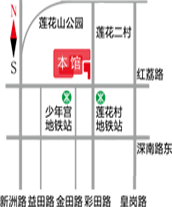
- Beijing Painting Record
-
Fu Baoshi
I remember before the liberation, on a snowy day at the foot of the Jingang Slope in Chongqing, I first read Chairman Mao's famous poem "Qinyuan Spring" praising snow, feeling extremely excited. The grandeur of the spirit, the boldness of the style, the superb artistic conception, and the richness of imagination strongly infected me. I like to paint landscapes, and I also enjoy appreciating famous poems and paintings. However, over the past few decades, I have painted countless times, but none of them have been satisfactory.
In early August of this year, when I returned from Chairman Mao's hometown of Shaoshan to paint, I accepted the task of creating a large painting for the Great Hall of the People in the capital. This painting is required to reflect the meaning of Chairman Mao's poem "Qinyuan Spring", which means "the rivers and mountains are so beautiful". The painting has an area of five and a half meters high and nine meters wide, which is unprecedented in the history of Chinese painting. The completion time of the painting is also very tight, and it is a very honorable and quite difficult task to complete before the National Day holiday.
When I first saw a fifty square meter canvas, many memories of the past came to my mind. The largest paper used for calligraphy and painting in Chinese history is a type called "zhang er pi". In fact, it is only about four to twelve inches high and about eleven meters wide. This type of paper was most popular during the Qianlong and Jiaqing periods of the Qing Dynasty, and by Guangxu, it became thicker and thicker. The fact that calligraphers and painters in the past were able to use this type of paper indicates that they had considerable experience. During the Ming Dynasty, Shen Shitian claimed that he only dared to paint "large paintings" after the age of forty. But according to the relics I have visited, Shen Shitian's "large size" is not larger than "two zhang horses". I got three pictures before the War of Resistance Against Japan. They seemed to be taken to Chongqing, but after the Japanese surrendered, they were taken to Nanjing. I always couldn't bear to draw them and didn't dare to draw them easily. It was really unnecessary to draw them. I once joked with a friend: I look like Shen Shitian. In 1952, I first drew a picture at the age of 48. In the past, this type of large canvas was rarely sought after, but now it is in short supply because many painters are constantly creating large paintings. Of course, the essence of the problem is not on paper. But such a piece of paper also indirectly reflects the rise and fall of national painting in our country.
Where does the ink come from for such a large painting? When my collaborator Guan Shanyue and I were brainstorming for composition, although we both believed that we should focus on describing "the rivers and mountains are so beautiful", we only circled around in the scenic part of the poem itself, intending to focus on portraying the artistic conception of "the scenery of the North, thousands of miles of ice, and thousands of miles of snow drifting". Vice Premier Chen Yi, Guo Moruo, Wu Han and many other leaders showed great concern for our painting and provided valuable suggestions, which greatly inspired us. Chairman Mao's poem, although titled "Ode to Snow", is not limited to the description of snow. Instead, it uses "Ode to Snow" to describe the vast and beautiful scenery of the motherland, with vivid emotions and heroic figures dedicating themselves to it. It perfectly embodies the heroic spirit of the Chinese people's revolutionary optimism. When the chairman wrote this poem, the whole country had not yet been liberated, and there was a phrase in the poem: "On a sunny day, looking at the red clothes and plain clothes, it is particularly enchanting.". However, the situation is different today. The "sun" has already come out, the "east is red", and its light has already shone on the land of our motherland. A red sun must be drawn on the screen. Our motherland is so vast and vast. When the fertile land of Jiangnan is in the warm sunshine, blooming with colorful flowers, and the Himalayas are still covered in white snow, the simultaneous appearance of the sun and snow in one picture, as well as different seasons of spring, summer, autumn, and winter, and the appearance of regions in the east, west, north, south, and north, does not make people feel contradictory or disharmonious. Isn't our excellent painting tradition of combining four seasons of mountains, waters, flowers, and birds into one painting?
During the drawing process, we have always been concerned about the effect of the painting, and with each stroke, we study it repeatedly. We strive to integrate the delicate and gentle Lingnan style of Guan Shanyue with my unrestrained and profound style on the screen, each with its own unique features. We must paint with vivid strokes and majestic momentum, without any delicate or powerless expression. Our entire creative process is a new attempt, and although we need to constantly explore the techniques of expression, even the tools used need to be redesigned. For example, some large and typesetting poles are over one meter long, like brooms; Use a large enamel basin for color mixing, with five or six in one swing. In terms of color tone, it is also important to carefully consider how to achieve unity and harmony. We adopt a heavy color of green mountains and rivers for the close-up view of the high mountains and pine trees, and a light green color for the principles of peace in the Great Wall and rivers, and then slowly blur over. In the distance, there is a vast sea of clouds and winding snow capped mountains. The sun in the upper right corner shone brightly with a red glow, breaking through the gloomy sky and making people feel "dressed in red, particularly enchanting."
At first, we only focused on considering that the image was too large and difficult to handle, hoping to make it as small as possible, but we did not consider the actual effect of the painting and the combination with the building. After the initial draft was drawn, it was brought to the scene for review by the responsible comrades. A series of unimaginable problems were discovered. Premier Zhou and all the leading comrades have given us many valuable instructions and insightful opinions upon seeing it: the sun is drawn too small, especially when viewed from under an eight meter wide staircase. It's like a duck egg yolk. The screen is too small, the gray tone of the sky is too loud, and it doesn't match the majestic buildings. We once imagined extending an ancient pine tree from the top left corner of the picture to increase the weight of the painting and cover up a large gray sky, but this still cannot make up for the shortcomings. Central officials have proposed that the image should be raised and widened, and the sun should be drawn larger. It may be better to exaggerate it, so that people can feel the great spirit of "the east is red, and the sun rises" at a glance. As soon as we got back, we immediately started to enlarge the picture, raise the snow mountains, draw the sun big and round, and let the red light of the morning glow shine on the earth.
This painting, from exploring the theme, managing the position... to writing with every stroke of ink, was almost always cared for and encouraged by the Party. Every stroke of our work, every stroke, was infused with the collective wisdom. The guidance of the central responsible comrades gave us the greatest encouragement, and as we swung our one meter long pen pole, it appeared particularly energetic. Heaven and earth are connected, mountains and rivers are connected, and finally it is completed in one go. What I will never forget is that on September 27th, Chairman Mao inscribed the six words "So many beautiful mountains and rivers" on our painting. I deeply realize that this is Chairman Mao's meticulous care for traditional ethnic painting; It is an encouragement to the enthusiasm of Chinese painting workers throughout the country, and it is also the supreme honor of Chinese painting workers throughout the country.
Chairman Mao often taught us that the work we are doing today is unprecedented. I have always remembered this sentence in my heart. Just like the Great Leap Forward achieved on the industrial and agricultural fronts, the art world has also seen a thriving scene. From Gu Kaizhi at the beginning of the fourth generation of Qi to Wu Changshuo at the beginning of the 20th century, no matter what they painted or from what perspective they looked at, who could compare with us - the painters of the whole country - for a distance of 1600 years? The great painting we created this time, although unprecedented in the history of Chinese painting, will soon become a "commonplace". Isn't it also possible to have a few paintings in cultural clubs or public places of the people's communes?



